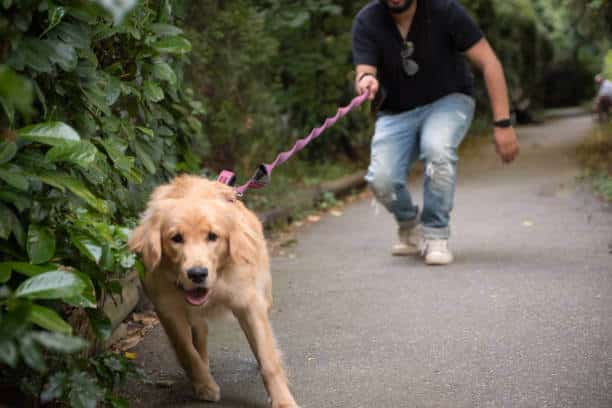Leash training is a must for any pup owner, as it teaches your pup how to behave while walking on a leash.
Is your puppy giving you a hard time on walks? Does your pup always seem to be pulling you in the wrong direction or not paying attention to you? If so, then leash training your pup is the answer. It also helps to create a positive bond between you and your pup. Keep reading to learn more about leash training your pup and how to make the experience stress-free.
What is Leash Training, and Why is it Important?
Leash training teaches your pup to walk on a leash without pulling or running away. It’s important for a number of reasons, including safety, health, and obedience. A pup who is leash-trained will be easier to control if it runs into an unexpected situation. It also helps to create a bond of trust between you and your pup, as you will be able to trust that your pup will follow your commands. Finally, leash training is a great way to help your pup get some exercise and stay healthy.
Preparing for Leash Training
Before you begin leash training your pup, it’s important to take some time to prepare. First, make sure that you have the right equipment. A comfortable, adjustable collar and leash are the best choices. Ensure that the collar isn’t too tight or loose and that the leash isn’t too long or too short. You should also choose a quiet, distraction-free area to begin leash training. This will help your pup focus and learn more quickly.
related article in our dogs world 101
Leash training a puppy can be a daunting task. You want to teach your furry friend to walk calmly by your side, but all they want to do is pull and run around like a wild animal. It’s like trying to train a toddler who’s had too much sugar.
I tried everything from using treats to using a gentle leader, but nothing seemed to work. My puppy would still tug on the leash and run after squirrels like it was her job.
But then, one day, I had an epiphany. I decided to let my puppy lead the way and follow her lead. And you know what? It worked! She started walking calmly beside me, sniffing around, and enjoying the sights and smells of the neighborhood.
So, if you’re struggling with leash training your puppy, don’t give up. Try different methods, follow your pup’s lead, and most importantly, have fun! Who knows, you might just learn something new about your furry friend.
If you want to learn more about puppy training and pet care, check out our blog for more tips and tricks!
Basic Steps for Leash Training a Puppy
Once you’ve chosen the right equipment and location, it’s time to begin leash training your pup. The first step is to attach the leash to the collar and then let your pup get used to it. Let your pup explore the area and get comfortable with the leash. After a few minutes, you can begin the training. Start by walking your pup a few steps at a time, using treats and verbal praise to reward good behavior. Make sure to keep the leash loose and stay consistent with the commands.
Tips for Successful Leash Training
Leash training your pup can be a challenging process, but there are a few tips that can help make it easier. First, be patient with your pup. It may take several weeks for them to learn the commands and become comfortable with the leash. Second, keep your commands short and simple. Your pup will have an easier time understanding one or two-word commands. Third, always reward your pup for good behavior. This will help reinforce the desired behavior and smooth the training process.
Understanding Puppy Behavior During Leash Training
It’s important to understand your pup’s behavior during leash training. Some pups may be hesitant or scared, while others may be excited and rambunctious. It’s important to be aware of your pup’s body language and any signs of stress. If your pup is showing signs of stress, take a break and try again later. You should also be aware of any distractions that may prompt your pup to pull on the leash.

Common Mistakes to Avoid When Leash Training
There are a few common mistakes that many people make when leash training their pups. First, don’t jerk the leash or pull on it. This will only confuse your pup and make it harder to learn. Second, don’t reward your pup for bad behavior. This will only encourage them to continue the behavior. Finally, don’t be too harsh when disciplining your pup. This can create a negative association with the training and make it more difficult for your pup to learn.
How to Deal With Leash Pulling

If your pup is pulling on the leash, there are a few things you can do. First, stop walking and wait for your pup to calm down. If your pup continues to pull, gently redirect them in the other direction. You can also use a short leash to help control your pup’s movements. Finally, if your pup continues pulling, you can use a harness. This will help to spread out the pressure and make it easier to control your pup.
Tools and Accessories for Leash Training
There are a few tools and accessories that can help to make leash training your pup easier. First, a head halter can help to control your pup’s head and discourage pulling. You can also use a no-pull harness or a special collar to make it easier to control your pup. Finally, using a treat pouch can help to reward your pup for good behavior.
Creating a Positive Reinforcement Schedule
Creating a positive reinforcement schedule is important for leash training your pup. This will help reinforce the desired behavior and smooth the training process. Start by rewarding your pup for even small successes and gradually increase the rewards for bigger successes. This will help keep your pup motivated and make the training process fun.
Leash Training Your Puppy Conclusion
Leash training your pup is an important part of being a responsible pet owner. It’s important to start leash training your pup as soon as possible, as it will help to create a bond of trust between you and your pup. With the right equipment, a positive reinforcement schedule, and patience, you can have your pup leash trained quickly. So don’t wait, start leash training your pup today and unlock the secret to a stress-free walk!
Remember… Owning a dog should be FUN, not a chore!
My name is Mark and I currently live in Australia.
I am passionate about educating Doggie parents and helping you to make the best possible decisions to help your dog live a long, happy and healthy life.
As a Dog trainer & behaviorist I have always used The Dog Solution methods with a 100% success rate.
Feel free to contact us, and stay tuned for updates and informative posts on dog care, training, diet, and much more!
“Dogs do speak, but only to those who know how to listen” – Orhan Pamuk




